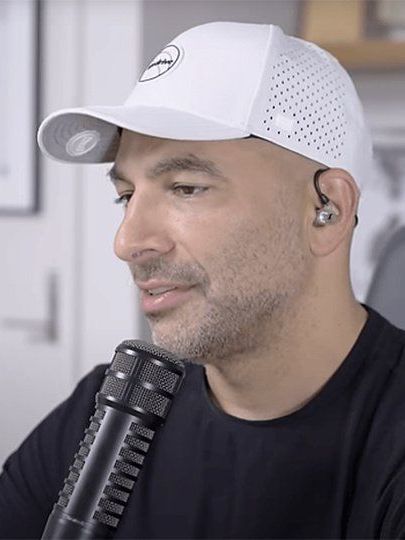Belly Fat: Why it’s so stubborn and how to persevere
Nutrition, sleep, and stress, all play a role.
Losing belly fat isn't just about doing crunches and eating salads. If you want that superhero bod, then we need to turn to some real-life superheroes in the health and fitness world.
To carry on (possibly too long) with the comic book tie-ins, this interview assembles The Avengers of longevity who provide science-backed truths about losing belly fat.
From debunking myths to crafting sustainable strategies, Jeremy Ethier compared insights from health and wellness experts Layne Norton, Alan Aragon, Eric Trexler, Bill Campbell, and Laurin Conlin to bring together these comprehensive concepts that focus on the successful way to reduce belly fat.
Here's the BodyStack breakdown of that chat which will help empower you with the knowledge you need to tackle that stubborn area for many - belly fat.
Types of Belly Fat
There are two primary types of belly fat: subcutaneous fat and visceral fat.
Subcutaneous Fat: The fat you can see and pinch, located just under the skin.
Visceral Fat: The deeper, more dangerous fat stored around internal organs that can be linked to serious health problems.
While both are undesirable, visceral fat is particularly concerning due to its strong association with various health risks, including heart disease and diabetes.
The Key to Losing Belly Fat
Targeting belly fat with specific exercises is a myth. The fundamental principle for losing any kind of fat, including belly fat, is creating a calorie deficit.
-
Caloric Deficit: The most effective way to lose fat, including belly fat, is to consistently consume fewer calories than your body burns.
-
Spot Reduction Myth: There's no evidence that specific exercises can target belly fat directly.
Consuming fewer calories than your body burns is a goal best achieved through a combination of diet and exercise. Here's some further reading on how to pull this off in a sustainable way.
Nutrition Plan for Fat Loss
A sustainable and enjoyable eating plan is crucial for long-term fat loss.
You NEED both if you don't want to fall off the wagon and "sustainable" and "enjoyable" is gonna mean different things to different people.
But there are a few universal truths that will help the battle with belly fat:
-
Track Calories: Determine your current daily caloric intake and then calculate the number of calories needed for fat loss (using tools like the builtwithsize.com calculator).
-
Focus on Whole Foods: Prioritize protein sources (meat, fish, and eggs), healthy fats (nuts, seeds, and avocados), fibrous vegetables, some starch, and limited fruit and dairy.
Don't forget to incorporate your favorite foods in moderation to avoid feeling deprived. A sustainable, successful diet is one you can stick with.
Protein Intake for Fat Loss
When trying to lose fat, protein plays a critical role by helping to preserve your hard-earned muscle mass and keeping your metabolism in high gear.
Preserves Muscle Mass: Adequate protein intake helps maintain muscle mass during a calorie deficit.
High Thermic Effect: Protein requires more energy to digest compared to carbs and fats, potentially aiding fat loss.
Recommendation: Aim for at least 1.6 grams of protein per kilogram of body weight (0.7 grams per pound).
Protein can give your fat-burning efforts an extra boost. How much you need depends on your body weight. You'll want to aim for at least 0.7 grams of protein per pound of body weight daily.
Visceral Fat and Food Choices
While overall fat loss is the most effective way to reduce visceral fat, certain dietary choices may influence its accumulation.
Diets high in saturated fats, often found in processed foods and red meat, can contribute to increased visceral fat.
Losing Fat Overall is Key: If you're losing overall body fat, visceral fat will decrease as well.
Fat Gain and Visceral Fat: Visceral fat is more of a concern when gaining weight.
Saturated Fat: Diets high in saturated fat may lead to greater visceral fat accumulation compared to those high in polyunsaturated fats.
Focusing on healthier fats, like those found in fish, nuts, and avocados, will support a healthier body composition.
Exercise for Fat Loss
Exercise is a powerful tool. Resistance training is essential for preserving muscle mass during a calorie deficit, and cardio can offset decreases in daily activity levels.
-
Resistance Training (Lifting Weights): Helps preserve muscle mass during fat loss, preventing your metabolism from slowing down and reducing the likelihood of regaining fat later.
-
Cardio: While not essential for fat loss, cardio can help maintain energy expenditure during a diet. It can be added to offset the decrease in non-exercise activity thermogenesis (NEAT). Zone 2 training could be your friend when it comes to cardio training.
Sleep and Belly Fat
Interestingly enough, sleep plays a significant role in belly fat accumulation. Inadequate sleep can disrupt hormones that regulate appetite and fat storage, leading to overeating and increased fat.
-
Sleep Deprivation: Lack of sleep can lead to overeating and weight gain, with fat preferentially stored in the belly area.
-
Sleep and Muscle Loss: Even with a calorie deficit, getting an insufficient amount of sleep can result in more muscle loss and less fat loss.
To ensure you get an adequate amount of sleep to support your weight loss goals, you should aim for seven to eight hours of quality sleep each night to start.
As you get further on your optimization, you may discover that you need more, or less sleep, but that eight-hour target is a simple starting benchmark.
When you're ready for it, we have many thoughts on ways to increase your deep sleep.
The Importance of Patience and Consistency
Progress takes time. It's important to be patient and focus on consistency rather than quick fixes.
Realistic Expectations: Belly fat is often the last area to see progress, so patience is crucial.
Track Progress: Use multiple metrics, like scale weight, measurements, and how your clothes are fitting to track your progress.
Don't Give Up: Be consistent and stick to a good plan, adjust it when necessary, and don't quit before seeing results.
Losing belly fat requires a multifaceted approach, encompassing both dietary and lifestyle adjustments. The process demands patience, consistency, and a willingness to learn.
Armed with the science-backed insights and practical tips from these experts, you're well on your way to a healthier, happier you.





